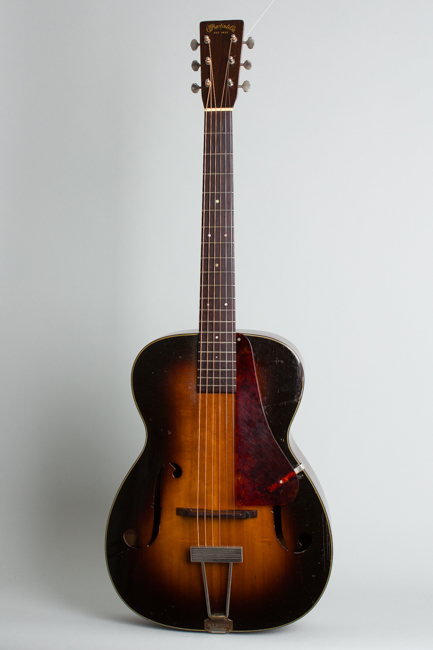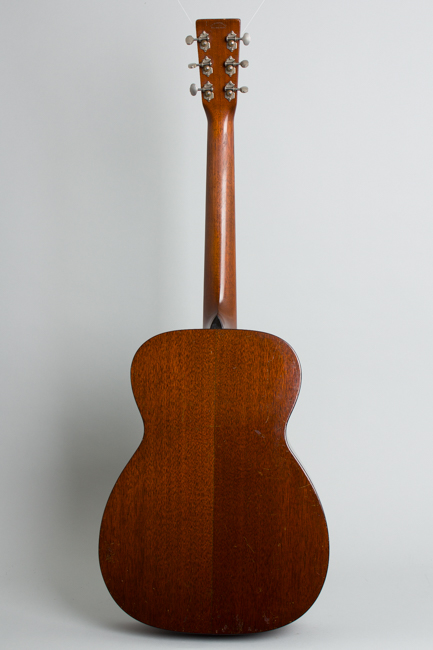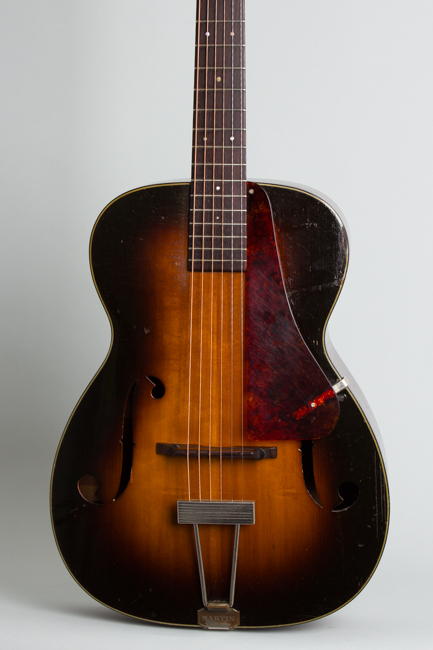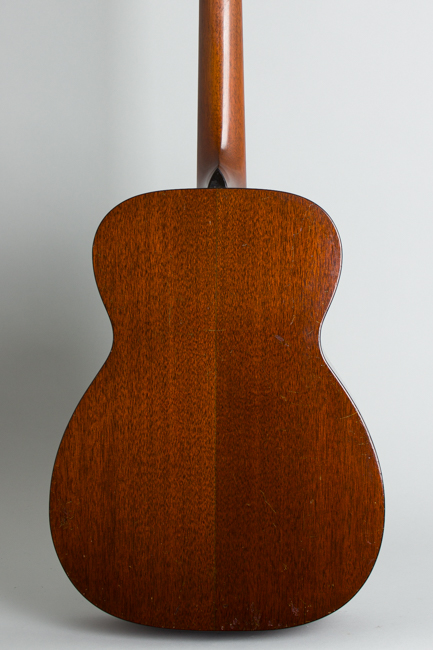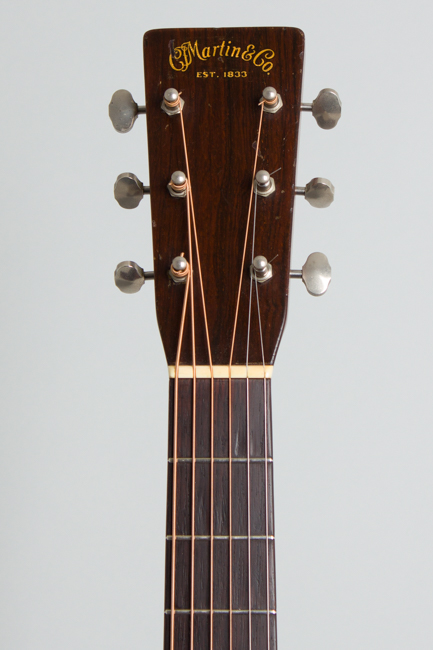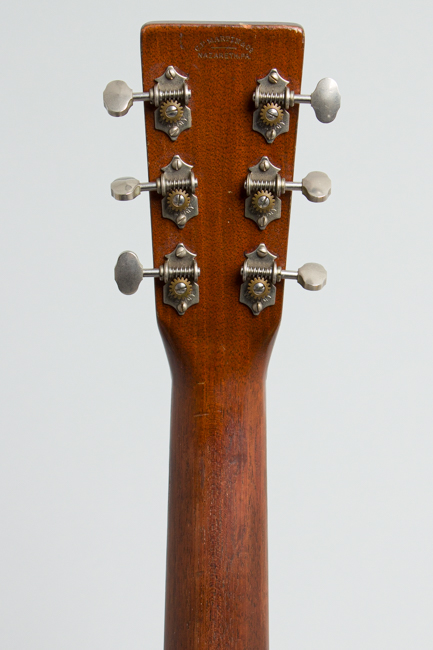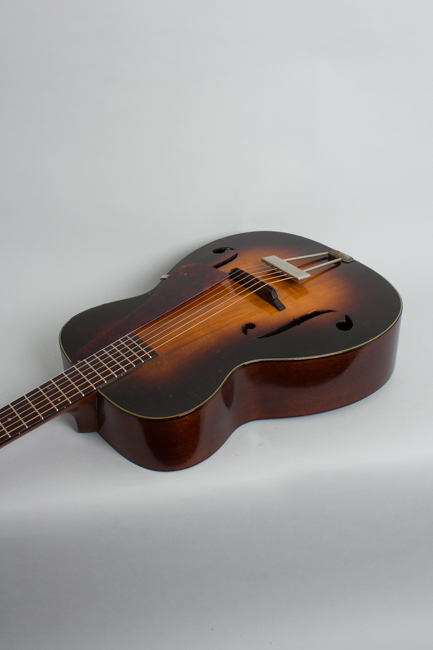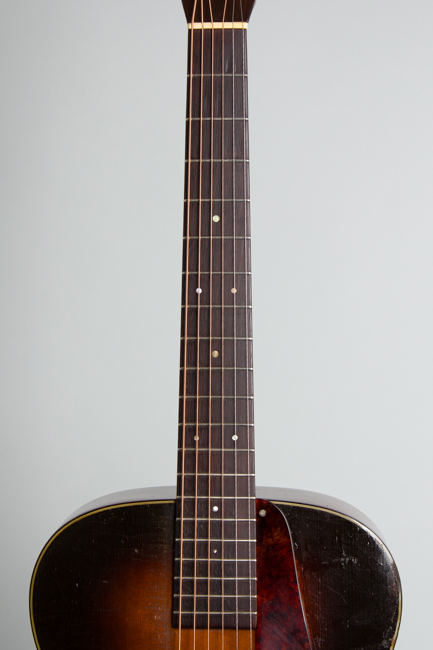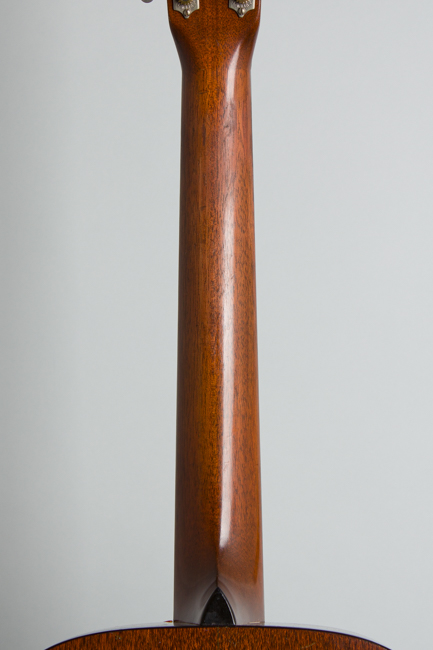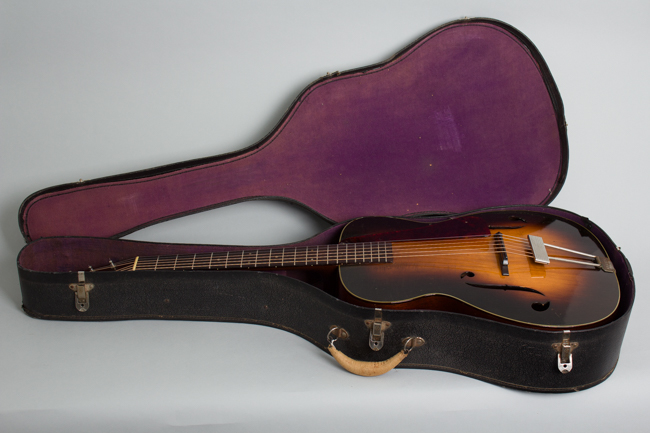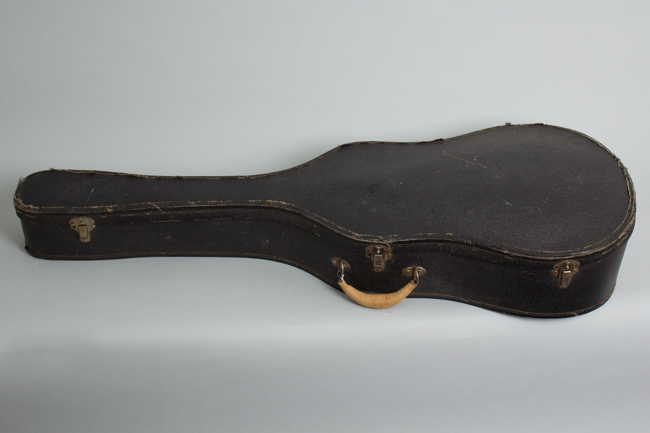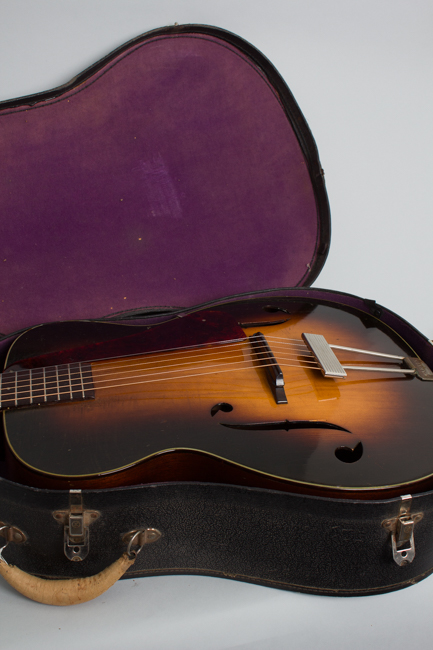C. F. Martin R-18 Arch Top Acoustic Guitar (1935)
C. F. Martin R-18 Model Arch Top Acoustic Guitar (1935), made in Nazareth, PA, serial # 59890, sunburst top, natural back and sides finish, mahogany back, sides and neck, spruce top, rosewood fingerboard, original black chipboard case.
One of C. F. Martin & Co.'s most overlooked guitars, the F-hole R-18 represents the lower end of the company's noble but ultimately doomed attempts to challenge Gibson and Epiphone for the swing-era archtop market. The R-series were Martin's budget archtop guitars, introduced in 1933 sporting a mix of flat- and arch-top style features. From the modern perspective Martin arch-tops have never been well-appreciated compared to flat tops, but in the middle of the depression this was a fairly popular guitar with 304 sold in 1935 alone.
Unlike Epiphone (and eventually many others) when designing their archtop line Martin chose not to directly copy Gibson but created what could best be described as hybrid instruments, built on their flat-top forms. The R-18 essentially took their 00-18-body, pitched the 14-fret neck way back and gave the top a gentle carved arch with segmented F-holes. Similar guitars emerged around this time from Washburn, Vega, and Weymann, among others. The R-18 was briefly introduced with a round soundhole before being quickly redesigned with F-holes in later 1933.
This version of the R-18 was produced up through the end of the decade. The model stood near the bottom of the Martin arch top line, with only the similar mahogany-top R-17 below it. The list price was $55 in July 1935, $5 more than the cost of a Gibson L-50. The features are distinctly Martin; the flat-backed mahogany body has a dark sunburst finished spruce top with typical Style 18 trim. The top on these earlier R-18's are solid spruce but pressed into shape over braces, not carved. In 1937 the top was altered to a carved pattern but by then the model was already in decline.
Like all prewar Martins of any price the workmanship is impeccable and all woods top-notch. The neck has a lovely rounded profile with just the hint of a soft "V"; the unbound rosewood fingerboard has a delicate slotted diamond inlay. The tailpiece is a heavy Grover piece with an engraved Martin logo on the base while the adjustable bridge is a lovely carved two-piece unit that is a work of art in itself.
The sound is very bright and punchy, quite focused but thinner than the typical mid-1930's Gibson. The feel is halfway between the typical arch top and flat top, with the smaller body making the feel comfortable to a typical Martin player. This is an excellent "acoustic lead" guitar as it has has a lot of cut, if not that much depth to the sound. While admittedly a minority taste, we find these Martin arch tops can be a fun guitar to play and are quite suited to some string band or similar playing applications, if the player is not expecting a flat top sound!
Overall length is 39 in. (99.1 cm.), 14 3/8 in. (36.5 cm.) wide at lower bout, and 4 1/4 in. (10.8 cm.) in depth, measured at side of rim. Scale length is 25 in. (635 mm.). Width of nut is 1 11/16 in. (43 mm.).
The R-18 has seem some fairly heavy wear and had a bit of work done, but overall is a great player for its age and price. The finish is original showing a decent amount of scratches, nicks, and dings overall, most heavily on the back and lower side. The top has some general wear, with some unusual drip marks on the upper treble bout. This is due to the original pickguard deteriorating, as many do, causing some finish melt underneath from the off-gassing. A modern repro pickguard is currently installed on the guitar.
The top and back are entirely crack free, although there are several deep scratches at the apex of the lower treble bout. The only notable cracks are located on the side: one running from the heel on the treble side, and an old impact crack on the lower bout of the treble side. Both have been sealed and show no signs of movement; some fill was added to the second. Internally, all of the original bracing remains untouched.
The neck may have been reset although that is unusual on these; the fingerboard planed and refretted. The fret wire used is comparable to the era, and the frets have been lightly polished. The original Grover trapeze tailpiece has been soldered at the hinge which has held up nicely; much of the plating is gone from that area. The original tuners have been replaced with butterbean Waverlys in the vintage style. The original bone nut and elegant carved bridge are still intact. The guitar plays very well; it is housed in what appears to be the original 1930's heavy chipboard case, but one more sized for a 00-18 flat top. Perhaps that what all the dealer had that day in 1935! Very Good + Condition.
One of C. F. Martin & Co.'s most overlooked guitars, the F-hole R-18 represents the lower end of the company's noble but ultimately doomed attempts to challenge Gibson and Epiphone for the swing-era archtop market. The R-series were Martin's budget archtop guitars, introduced in 1933 sporting a mix of flat- and arch-top style features. From the modern perspective Martin arch-tops have never been well-appreciated compared to flat tops, but in the middle of the depression this was a fairly popular guitar with 304 sold in 1935 alone.
Unlike Epiphone (and eventually many others) when designing their archtop line Martin chose not to directly copy Gibson but created what could best be described as hybrid instruments, built on their flat-top forms. The R-18 essentially took their 00-18-body, pitched the 14-fret neck way back and gave the top a gentle carved arch with segmented F-holes. Similar guitars emerged around this time from Washburn, Vega, and Weymann, among others. The R-18 was briefly introduced with a round soundhole before being quickly redesigned with F-holes in later 1933.
This version of the R-18 was produced up through the end of the decade. The model stood near the bottom of the Martin arch top line, with only the similar mahogany-top R-17 below it. The list price was $55 in July 1935, $5 more than the cost of a Gibson L-50. The features are distinctly Martin; the flat-backed mahogany body has a dark sunburst finished spruce top with typical Style 18 trim. The top on these earlier R-18's are solid spruce but pressed into shape over braces, not carved. In 1937 the top was altered to a carved pattern but by then the model was already in decline.
Like all prewar Martins of any price the workmanship is impeccable and all woods top-notch. The neck has a lovely rounded profile with just the hint of a soft "V"; the unbound rosewood fingerboard has a delicate slotted diamond inlay. The tailpiece is a heavy Grover piece with an engraved Martin logo on the base while the adjustable bridge is a lovely carved two-piece unit that is a work of art in itself.
The sound is very bright and punchy, quite focused but thinner than the typical mid-1930's Gibson. The feel is halfway between the typical arch top and flat top, with the smaller body making the feel comfortable to a typical Martin player. This is an excellent "acoustic lead" guitar as it has has a lot of cut, if not that much depth to the sound. While admittedly a minority taste, we find these Martin arch tops can be a fun guitar to play and are quite suited to some string band or similar playing applications, if the player is not expecting a flat top sound!
Overall length is 39 in. (99.1 cm.), 14 3/8 in. (36.5 cm.) wide at lower bout, and 4 1/4 in. (10.8 cm.) in depth, measured at side of rim. Scale length is 25 in. (635 mm.). Width of nut is 1 11/16 in. (43 mm.).
The R-18 has seem some fairly heavy wear and had a bit of work done, but overall is a great player for its age and price. The finish is original showing a decent amount of scratches, nicks, and dings overall, most heavily on the back and lower side. The top has some general wear, with some unusual drip marks on the upper treble bout. This is due to the original pickguard deteriorating, as many do, causing some finish melt underneath from the off-gassing. A modern repro pickguard is currently installed on the guitar.
The top and back are entirely crack free, although there are several deep scratches at the apex of the lower treble bout. The only notable cracks are located on the side: one running from the heel on the treble side, and an old impact crack on the lower bout of the treble side. Both have been sealed and show no signs of movement; some fill was added to the second. Internally, all of the original bracing remains untouched.
The neck may have been reset although that is unusual on these; the fingerboard planed and refretted. The fret wire used is comparable to the era, and the frets have been lightly polished. The original Grover trapeze tailpiece has been soldered at the hinge which has held up nicely; much of the plating is gone from that area. The original tuners have been replaced with butterbean Waverlys in the vintage style. The original bone nut and elegant carved bridge are still intact. The guitar plays very well; it is housed in what appears to be the original 1930's heavy chipboard case, but one more sized for a 00-18 flat top. Perhaps that what all the dealer had that day in 1935! Very Good + Condition.
